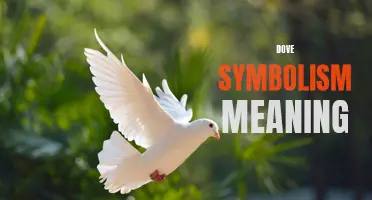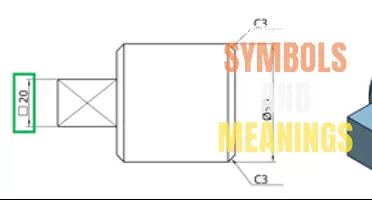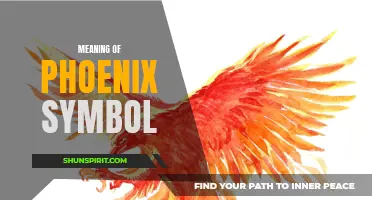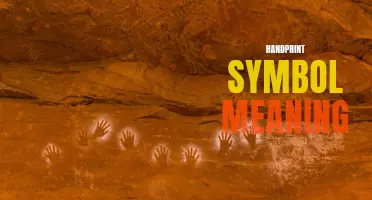
Masonry, known for its intricate symbolism and hidden meanings, has been an enigma for centuries. From the square and compass to the all-seeing eye, each symbol holds a deeper significance within the mysterious world of Freemasonry. Delving into the symbolism of masonry is like peeling back the layers of a well-guarded secret, uncovering a rich tapestry of ancient wisdom and philosophical teachings. Join us as we explore the captivating world of masonry symbol meaning and unveil the hidden truths behind these mystical emblems.
What You'll Learn
- What is the primary meaning of the Masonry symbol and what does it represent?
- How does the Masonry symbol vary between different Masonic orders or lodges?
- Can you explain the history and origins of the Masonry symbol and how it has evolved over time?
- Are there any hidden or esoteric meanings associated with the Masonry symbol?
- How does the Masonry symbol tie into the rituals and ceremonies of the Masonic fraternity?

What is the primary meaning of the Masonry symbol and what does it represent?
The Masonry symbol holds significant meaning and represents several concepts within the Masonic fraternity. This ancient fraternity is steeped in symbolism, with each symbol carrying a unique message for its members.
The primary meaning of the Masonry symbol is that of a square and compass intertwined. The square and compass represent two essential tools used by masons in construction and masonry work. The square represents morality and fairness, while the compass represents spiritual and intellectual development.
The square reminds members to act with fairness, honesty, and integrity in their daily lives. It symbolizes the importance of adhering to moral principles and treating others with respect and dignity. It serves as a constant reminder for Masons to be upright and just in their dealings.
The compass, on the other hand, signifies a Mason's ability to circumscribe their desires and keep their passions within due bounds. It encourages individuals to develop their spiritual and intellectual capacities, guiding them towards self-improvement and personal growth. The compass reminds Masons to maintain balance and harmony between their physical, mental, and spiritual selves.
When the square and compass are intertwined, they form the Masonry symbol known as the square and compasses. This emblem represents the unity and interdependence of moral behavior and intellectual development. It signifies the essence of Masonic teachings, namely the pursuit of personal and societal improvement through the cultivation of virtuous qualities.
The symbol also carries additional layers of meaning. The square and compass can be seen as representing the duality of humanity - the physical and spiritual aspects that are inherent in each individual. It encourages Masons to strive for balance and harmony between these two realms, recognizing the importance of nurturing both their material and immaterial selves.
Furthermore, some interpret the square and compasses as representing the earthly and celestial spheres. The square symbolizes the material world and the physical existence, while the compass represents the spiritual and metaphysical dimensions. It encourages Masons to explore and study both realms, seeking to understand the mysteries of the universe and their place within it.
In conclusion, the primary meaning of the Masonry symbol, the square and compass, represents a combination of moral behavior and intellectual development. It serves as a reminder for Freemasons to uphold principles of fairness, honesty, and integrity in their daily lives while nurturing their spiritual and intellectual growth. Ultimately, the symbol encourages Masons to strive for personal improvement and the betterment of society as a whole.
The Symbolic Meaning of Lions: Power, Courage, and Majestic Authority
You may want to see also

How does the Masonry symbol vary between different Masonic orders or lodges?
The Masonry symbol, also known as the Square and Compasses, is one of the most widely recognized symbols associated with Freemasonry. It represents the principles and teachings of the Masonic fraternity. However, the way this symbol is depicted can vary between different Masonic orders or lodges.
The basic Masonry symbol consists of two tools: the square and the compasses. The square represents morality and virtue, while the compasses represent the boundaries and limitations that should be observed in a Mason's conduct. Together, these tools symbolize the principles of Freemasonry and guide Masons in their daily lives.
While the basic interpretation of the Masonry symbol remains the same across different Masonic orders, the way it is depicted can vary. This variation can be seen in the design and detail of the symbol, as well as the inclusion of additional elements or symbols alongside the square and compasses.
Different Masonic orders or lodges may have their own unique interpretation of the Masonry symbol. For example, the Scottish Rite Masons often depict the symbol with a double-headed eagle, which represents their degrees and hierarchy within the organization. Other orders may incorporate specific symbols or emblems that are meaningful to their particular traditions or teachings.
Additionally, the size and placement of the Masonry symbol can also vary. Some lodges may choose to display a large, prominent emblem on their buildings or regalia, while others may opt for a smaller, more subtle representation. The location of the symbol can also differ, with some lodges placing it on their aprons, while others may display it on their furniture or banners.
The variations in the Masonry symbol are a reflection of the diverse nature of Freemasonry itself. Freemasonry has existed for centuries and has evolved and adapted over time. Different Masonic orders or lodges may have their own unique rituals, customs, and teachings, which can be reflected in their interpretation of the Masonry symbol.
It is worth noting that while the Masonry symbol may vary between different Masonic orders or lodges, the fundamental principles and values it represents remain consistent. The square and compasses symbolize the importance of living a moral and virtuous life, grounded in the values of Freemasonry.
In conclusion, the Masonry symbol, also known as the Square and Compasses, is a widely recognized symbol associated with Freemasonry. While the basic interpretation of the symbol remains the same, the way it is depicted can vary between different Masonic orders or lodges. These variations can include differences in design, the inclusion of additional symbols, and the size and placement of the symbol. These variations are a reflection of the diverse nature of Freemasonry and the unique traditions and teachings of each Masonic order or lodge.
Unlocking the Hidden Meanings Behind Symbols: A Journey into the Power of Symbolism
You may want to see also

Can you explain the history and origins of the Masonry symbol and how it has evolved over time?
The Masonry symbol is one of the most widely recognized symbols in the world. It has a long and mysterious history that dates back centuries. This symbol, also known as the square and compasses, is associated with Freemasonry, a secretive fraternal organization that traces its origins to the stonemasons' guilds of the Middle Ages.
The origins of the Masonry symbol can be traced back to the medieval stonemasons, who were highly skilled craftsmen responsible for constructing cathedrals, castles, and other important buildings. These stonemasons formed guilds, or associations, to protect their trade secrets and ensure high standards of craftsmanship.
As the guilds grew in size and influence, they began to admit members who were not actually stonemasons but were interested in the guild's philosophical and moral teachings. This expansion led to the formation of speculative Freemasonry, which focused more on the moral and philosophical aspects of the craft rather than the technical skills.
With the rise of speculative Freemasonry, a new set of symbols and rituals began to emerge. One of these symbols was the square and compasses, which came to represent the moral and philosophical teachings of the fraternity. The square symbolizes morality, while the compasses represent wisdom and understanding.
Over time, the Masonry symbol has evolved to incorporate other symbols and emblems that are associated with Masonic teachings. These may include the letter "G," which stands for God, the all-seeing eye, which symbolizes the watchful eye of God, and various architectural and geometric shapes.
The exact meaning of the Masonry symbol is a closely guarded secret among Freemasons. It is said to hold different meanings for different individuals and may be interpreted in various ways based on a person's personal beliefs and experiences. For some, it is a reminder to always act with integrity and fairness. For others, it represents the pursuit of knowledge and self-improvement.
In addition to its symbolism, the Masonry symbol is also highly recognizable and has been used in various contexts throughout history. It has appeared on Masonic lodges, regalia, and documents, as well as on currency and government seals. Its use continues to be a source of controversy and debate, with some associating it with conspiracy theories and secret societies.
In conclusion, the Masonry symbol has a rich and complex history that dates back centuries. Its origins can be traced back to the medieval stonemasons' guilds, and it has since evolved to become a powerful symbol of moral and philosophical teachings within Freemasonry. Its exact meaning remains a mystery, but its symbolism and recognition are indisputable.
Decoding the Dish: Understanding the Symbols and Meanings Behind Dishware
You may want to see also

Are there any hidden or esoteric meanings associated with the Masonry symbol?
Masonry is an age-old fraternal organization that has long intrigued scholars, historians, and conspiracy theorists alike. Just as with any secret society, Masonry is associated with a multitude of symbols that hold deeper meanings and significance. The most prominent of these symbols is the Masonic square and compass, often displayed on buildings, books, rings, and other Masonic paraphernalia. While it may appear simple at first glance, the square and compass holds hidden and esoteric meanings that add to its mystique.
The square and compass is a visual representation of the tools used by operative stonemasons during the Middle Ages. However, in the context of Masonry, these tools take on a more symbolic meaning. The square represents morality, fairness, and the right angle, while the compass represents the boundaries and limitations of human behavior. Together, they symbolize the principles that Masons strive to uphold in their personal and professional lives.
Beyond these surface-level interpretations, there are several esoteric meanings associated with the square and compass. One interpretation suggests that the square represents the physical realm, while the compass represents the spiritual realm. The intersection of the two tools signifies the harmony and balance between the material and the spiritual aspects of life. This interpretation highlights the Masonic belief in the importance of achieving balance and harmony in all aspects of life.
Another esoteric interpretation of the square and compass suggests that the two tools represent the masculine and feminine principles. The square represents the masculine principle, characterized by strength, stability, and logic, while the compass represents the feminine principle, associated with intuition, creativity, and flexibility. This interpretation emphasizes the significance of embracing and integrating both masculine and feminine qualities within oneself.
In addition to these interpretations, the square and compass also holds numerical symbolism. The square, with its four sides, represents the number four, which is believed to symbolize stability, foundation, and the four elements (earth, fire, air, water). The compass, with its two legs forming a V shape, represents the number two, symbolizing duality, polarity, and the two pillars often seen in Masonic symbolism. Together, the numbers four and two further illustrate the concepts of balance and harmony that Masons strive to achieve.
It is important to note that these esoteric interpretations of the square and compass are not universally accepted among Masons, and there are varying degrees of symbolism attributed to these symbols within the Masonic community. Some Masons may adhere to these interpretations, while others may view the symbols solely as a representation of the tools used by operative stonemasons.
In conclusion, the square and compass symbol of Masonry carries hidden and esoteric meanings that add to its allure. While the symbols represent morality, fairness, boundaries, and limitations on the surface level, they also have deeper meanings related to the harmony between the material and spiritual realms, the integration of masculine and feminine principles, and the numerical symbolism of balance and foundation. These interpretations contribute to the mystique and symbolism associated with Masonry and its symbols.
Decoding the Meaning Behind Keith Haring's Iconic Symbols
You may want to see also

How does the Masonry symbol tie into the rituals and ceremonies of the Masonic fraternity?
The Masonic fraternity, also known as Freemasonry, is a secret society that has been around for centuries. It is a fraternal organization that has its roots in the stonemason guilds of the Middle Ages. One of the most recognizable features of Freemasonry is its use of symbols, and one of the most prominent of these symbols is the Masonic square and compass.
The Masonic square and compass symbol is an emblem that consists of a square and a set of compasses, intertwined with each other. The square represents morality and the compasses represent knowledge and learning. Together, they represent the cornerstone of Freemasonry, which is the pursuit of knowledge and morality.
The square and compass symbol is an integral part of Masonic rituals and ceremonies. It is prominently displayed in Masonic lodges and is used as a focal point during rituals. The symbol is also used to teach Masonic lessons and principles. It serves as a reminder to Masons to strive for moral and intellectual growth and to always seek the truth.
During initiation rituals, the square and compass symbol plays a central role. It is used to conduct certain symbolic actions, such as testing the candidate's knowledge and guiding them through the Masonic ceremony. The symbol is used as a tool to impress upon new members the importance of morality and knowledge in Masonic teachings.
In addition to its use in rituals and ceremonies, the square and compass symbol is also seen on Masonic regalia and other Masonic paraphernalia. It is often found on aprons, rings, and other items used by Masons. The symbol serves as a reminder of the values and principles that Freemasonry holds dear.
The square and compass symbol has deep meaning within the Masonic fraternity. It represents the core principles of Freemasonry, including morality, knowledge, and intellectual growth. The symbol is used in rituals and ceremonies to impart these principles to new members and to remind existing members of their Masonic obligations.
Overall, the Masonic square and compass symbol is a powerful emblem that ties into the rituals and ceremonies of the Masonic fraternity. It serves as a reminder of the values and principles that Freemasonry upholds and serves as a tool to teach and impart Masonic teachings. The symbol is a visual representation of the cornerstone of Freemasonry, and its presence in Masonic lodges and rituals is a testament to the enduring importance of these principles.
The Symbolic Meaning Behind the Sacred Symbols of Baptism
You may want to see also
Frequently asked questions
In freemasonry, the compass symbolizes an important aspect of moral compass and guidance. It represents the ability to distinguish between right and wrong, and to make ethical decisions based on these principles. It is often used as a reminder to masons to always be mindful of their actions and uphold their values.
The square is a symbol of morality in freemasonry. It represents fairness, righteousness, and honesty. It reminds masons to square their actions with the principles of integrity and virtue. The square serves as a constant reminder to strive for moral uprightness and to hold oneself accountable to a higher standard.
The plumb is a symbol of upright conduct in freemasonry. It represents the importance of maintaining a straight and honest path in life. It signifies the need for moral rectitude and integrity in all actions and decisions. The plumb serves as a reminder for masons to always conduct themselves with honesty and fairness.
The trowel is a symbol of unity in freemasonry. It is used in the ritual of spreading cement or mortar to bind bricks together, and this act represents the importance of unity and harmony among masons. The trowel symbolizes the need to build strong connections and bonds with fellow masons, as well as the importance of working together towards a common goal.
The level symbolizes equality in freemasonry. It represents the idea that all masons are equal and should be treated as such, regardless of social status or background. The level serves as a reminder to masons to treat others with respect and fairness, and to work towards creating a society that values equality and justice.







